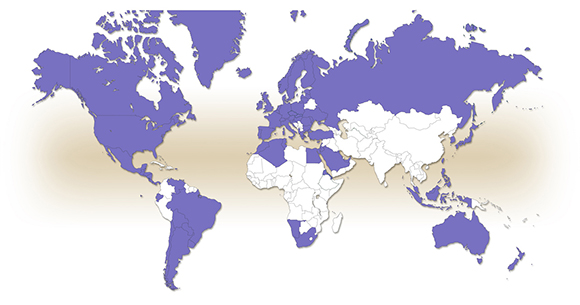DECT Technology
DECT - Worldwide Wireless Technology
Since its creation in 1992, DECT (Digital Enhanced Cordless Telecommunications) technology has supported both voice and data services on any spectrum allocated to DECT, and describes the radio interface. The key parameters determining the use of DECT are part of the ETSI Base standard. DECT, DECT 6.0 (DECT in NA/LATAM) and their successor CAT-iq, are adopted in more than 100 countries worldwide (see map). Other developments in the standard are described below. An overview of the spectrum allocation by country is available in the member section.

DECT Basic Standard
The DECT base standard EN 300 175-1: published by ETSI (European Telecommunications Standards Institute) – standardizes the air interface for DECT voice and data traffic. The DECT standard has seen huge worldwide widespread adoption on radio spectrum close to that assigned in the European CEPT region. DECT provides personal telecommunication services in residential and enterprise environments.
It is particularly targeted at the following applications:
· Residential: narrowband voice services;
· Enterprise: Includes PBXs and associated telephones, headsets, intercom systems, conferencing systems);
· ULE - Ultra Low Energy is a 100% DECT compatible technology standard for battery powered devices using the DECT radio spectrum.
· Machine to machine or machine to man wireless communications (e.g. monitoring and metering devices);
· DECT is also used increasingly in Program Making and Special Events use cases both indoor and outdoor, e.g. wireless intercom for event coordination.
CAT-iq
CAT-iq is a key voice and networking technology in home gateways. CAT-iq stands for Cordless Advanced Technology - internet and quality.
The underlying ETSI standard for CAT-iq is called DECT New Generation. This is the basis for the transformation of the DECT technolgy from the Public Switched Telephone Network (PSTN) to an all IP network.
CAT-iq integrates the DECT base station into the home gateway, giving it native IP connectivity for voice and data services. This increase in bandwidth make new operator services possible. Many of the voice related services are part of the SIP extended services profile and include features like call forwarding, multiple lines, event notification and many more. CAT-iq also enables HD Voice and CAT-iq certified devices may make use the HD Voice logo from the GSMA.
CAT-iq 2.0 is also accompanied by the DECT Forum certification program. Certification can be gained by fulfilling tests for Audio, RF and protocol. Certified CAT-iq 2.0 handsets from different system vendors can be used on the same certified base station. They are interoperable with other CAT-iq handsets and gateways as well as being backward compatible to DECT GAP products.
CAT-iq 2.1 adds extended functionality like conferencing and improved power saving functionality. CAT-iq 2.1 also contains CAT-iq 1.0 and 2.0 within its functional scope and is backward compatible to both. The accompanying certification program is similar to the program for CAT-iq 2.0 with the additional requirement of an application test suite which uses a test bench and several golden devices to prove the interoperability of certified devices all of which serves to greatly improve the user experience.
ULE
Ultra Low Energy was standardized in 2013 in ETSI TS 103939-1 and increasingly found in wireless home networks and many other applications requiring reliable power saving connectivity.
ITU-R - Worldwide DECT Frequencies
DECT is part of the IMT-2000 family. DECT is called IMT-2000 FDMA/TDMA, and is defined in ITU-R Recommendation M.1457-9 (05/2010). DECT Forum and ETSI TC DECT are also a technology proponent for IMT-2020 with DECT-2020.
 Europe
Europe
DECT, CAT-iq , ULE, DECT Evolution all operate on frequencies between 1880MHz -1920 MHz.
NA / LATAM
DECT, DECT-6.0, CAT-iq, ULE, DECT Evolution all operate in the USA in the UPCS band 1920-1930 MHz. The UPCS rules are found in FCC Part 15 Subpart D.
Japan
DECT in Japan is working in the 1894 MHz to 1904 MHz band and is branded as J-DECT
Please contact secretariat@dect.org to find out your country's DECT spectrum.